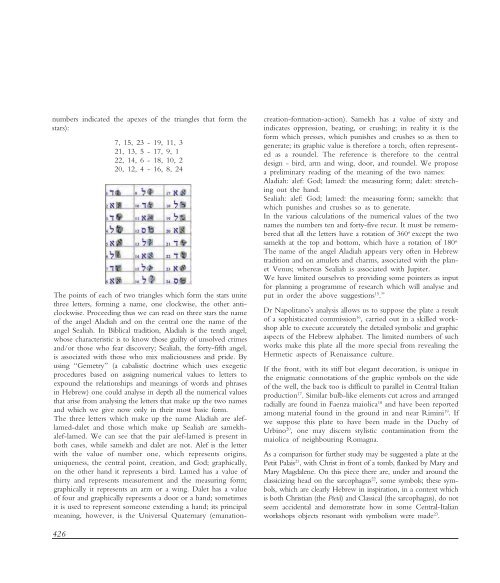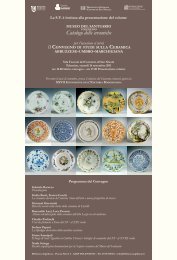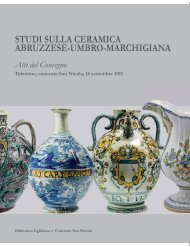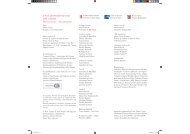Le maioliche rinascimentali nelle collezioni della ... - Claudio Paolinelli
Le maioliche rinascimentali nelle collezioni della ... - Claudio Paolinelli
Le maioliche rinascimentali nelle collezioni della ... - Claudio Paolinelli
You also want an ePaper? Increase the reach of your titles
YUMPU automatically turns print PDFs into web optimized ePapers that Google loves.
numbers indicated the apexes of the triangles that form the<br />
stars):<br />
426<br />
7, 15, 23 - 19, 11, 3<br />
21, 13, 5 - 17, 9, 1<br />
22, 14, 6 - 18, 10, 2<br />
20, 12, 4 - 16, 8, 24<br />
The points of each of two triangles which form the stars unite<br />
three letters, forming a name, one clockwise, the other anticlockwise.<br />
Proceeding thus we can read on three stars the name<br />
of the angel Aladiah and on the central one the name of the<br />
angel Sealiah. In Biblical tradition, Aladiah is the tenth angel,<br />
whose characteristic is to know those guilty of unsolved crimes<br />
and/or those who fear discovery; Sealiah, the forty-fifth angel,<br />
is associated with those who mix maliciousness and pride. By<br />
using “Gemetry” (a cabalistic doctrine which uses exegetic<br />
procedures based on assigning numerical values to letters to<br />
expound the relationships and meanings of words and phrases<br />
in Hebrew) one could analyse in depth all the numerical values<br />
that arise from analysing the letters that make up the two names<br />
and which we give now only in their most basic form.<br />
The three letters which make up the name Aladiah are aleflamed-dalet<br />
and those which make up Sealiah are samekhalef-lamed.<br />
We can see that the pair alef-lamed is present in<br />
both cases, while samekh and dalet are not. Alef is the letter<br />
with the value of number one, which represents origins,<br />
uniqueness, the central point, creation, and God; graphically,<br />
on the other hand it represents a bird. Lamed has a value of<br />
thirty and represents measurement and the measuring form;<br />
graphically it represents an arm or a wing. Dalet has a value<br />
of four and graphically represents a door or a hand; sometimes<br />
it is used to represent someone extending a hand; its principal<br />
meaning, however, is the Universal Quaternary (emanation-<br />
creation-formation-action). Samekh has a value of sixty and<br />
indicates oppression, beating, or crushing; in reality it is the<br />
form which presses, which punishes and crushes so as then to<br />
generate; its graphic value is therefore a torch, often represented<br />
as a roundel. The reference is therefore to the central<br />
design - bird, arm and wing, door, and roundel. We propose<br />
a preliminary reading of the meaning of the two names:<br />
Aladiah: alef: God; lamed: the measuring form; dalet: stretching<br />
out the hand.<br />
Sealiah: alef: God; lamed: the measuring form; samekh: that<br />
which punishes and crushes so as to generate.<br />
In the various calculations of the numerical values of the two<br />
names the numbers ten and forty-five recur. It must be remembered<br />
that all the letters have a rotation of 360 o except the two<br />
samekh at the top and bottom, which have a rotation of 180 o.<br />
The name of the angel Aladiah appears very often in Hebrew<br />
tradition and on amulets and charms, associated with the planet<br />
Venus; whereas Sealiah is associated with Jupiter.<br />
We have limited ourselves to providing some pointers as input<br />
for planning a programme of research which will analyse and<br />
put in order the above suggestions 15 .”<br />
Dr Napolitano’s analysis allows us to suppose the plate a result<br />
of a sophisticated commission 16 , carried out in a skilled workshop<br />
able to execute accurately the detailed symbolic and graphic<br />
aspects of the Hebrew alphabet. The limited numbers of such<br />
works make this plate all the more special from revealing the<br />
Hermetic aspects of Renaissance culture.<br />
If the front, with its stiff but elegant decoration, is unique in<br />
the enigmatic connotations of the graphic symbols on the side<br />
of the well, the back too is difficult to parallel in Central Italian<br />
production 17 . Similar bulb-like elements cut across and arranged<br />
radially are found in Faenza maiolica 18 and have been reported<br />
among material found in the ground in and near Rimini 19 . If<br />
we suppose this plate to have been made in the Duchy of<br />
Urbino 20 , one may discern stylistic contamination from the<br />
maiolica of neighbouring Romagna.<br />
As a comparison for further study may be suggested a plate at the<br />
Petit Palais 21 , with Christ in front of a tomb, flanked by Mary and<br />
Mary Magdalene. On this piece there are, under and around the<br />
classicizing head on the sarcophagus 22 , some symbols; these symbols,<br />
which are clearly Hebrew in inspiration, in a context which<br />
is both Christian (the Pietà) and Classical (the sarcophagus), do not<br />
seem accidental and demonstrate how in some Central-Italian<br />
workshops objects resonant with symbolism were made 23 .








